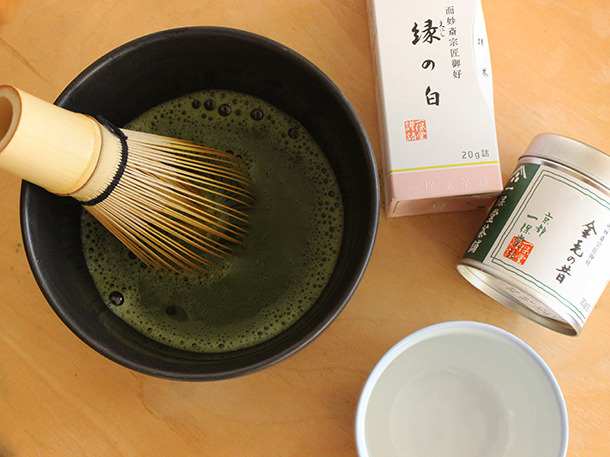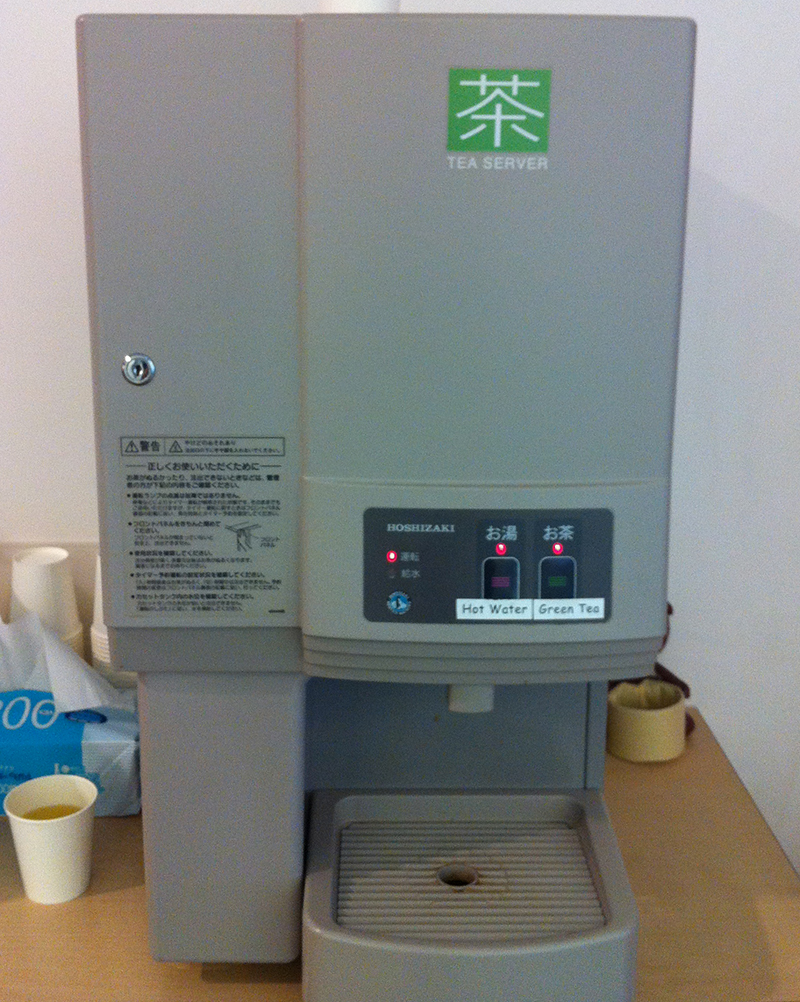 Ippodo Matcha
Ippodo Matcha
Matcha, gyokuro, sencha, hojicha, these are familiar terms to Japanese tea lovers, but to many Americans they’re still pretty obscure. To be honest, I think it’s hard to find really great examples of these teas outside of Japan. That’s why I’m so excited to bring in several varieties from Ippodo Tea Co., one of Japan’s premier tea companies based in Boston’s sister-city, Kyoto.
Ippodo was founded nearly 300 years ago, in 1717 during Japan’s Edo period. With their close proximity to the Kyoto Imperial Palace and a commitment to high quality tea, they quickly attracted the attention of members of the Imperial family. In 1846 Prince Yamashina formalized this long-standing relationship by giving the store the name Ippodo (一保堂, literally “preserve one”) in the hopes the shop would “forever preserve its tradition of providing high quality tea with a supreme taste.” Almost 170 years later, Ippodo is still committed to that mandate – carefully selecting the finest leaves from around Kyoto. This area is the most renowned, high-end tea growing region in the country, thanks to a mineral-rich soil, mild climate, and a delicate balance of sunshine and rainfall (as well as the longest history of tea cultivation in Japan!).
Many Americans know of the Japanese tea ceremony, an extremely formal and artful method of tea preparation that takes years of practice to master and is a world-renowned symbol of Japanese culture; however, people in Japan drink tea far more casually than that every day. The preparation is a little different (often smaller servings than the mugs we’re used to here in the states), and there certainly are “best practices” for extracting the fullest flavors (usually involving a Japanese style tea pot), but for the most part you can enjoy these teas with however much or little fuss you feel like putting into them. Classic everyday Japanese teas are hojicha, sencha and some types of matcha, while gyokuro and other matchas traditionally require a bit more work.
 A machine for dispensing little cups of green tea that I encountered last month in Japan! Proof that not every cup has to be hard to make.
A machine for dispensing little cups of green tea that I encountered last month in Japan! Proof that not every cup has to be hard to make.
Now that they’re here, I've had so much fun folding Ippodo’s teas into my weekly tea drinking routine – from formal to casual preparation styles. Here’s a quick rundown on what each of these tea-types means, and how to get the most out of their unique flavors!
Matcha
Ippodo’s matchas are all made from gyokuro green tea, the leaves carefully destemmed and deveined before being ground into a fine powder. In addition to differences between most U.S. and Japanese matcha, there are many different grades of matcha in Japan, all of which can be broken down into two rough categories – those for preparing “thin tea” (usucha 薄茶) and those for preparing “thick tea” (koicha 濃茶). Most matcha is consumed as the thinner usucha, but for special occasions (and formal tea ceremonies), koicha is a real treat. Traditional matcha preparation uses a bamboo whisk for mixing with water; however, I know many people who toss it into smoothies or froth it with milk for matcha lattes (and I have fond memories of using a coffee stirrer to make low-grade matcha at conveyer belt sushi restaurants!). Perhaps the easiest way to make good matcha is to add it to hot water in a thermos and then shake until mixed for on-the-go enjoyment! Ippodo has an amazing set of short tutorials on matcha preparation that are a must for anyone looking to hone their technique.
Matcha Best Practices:
- Water should calm from a boil to ~80oC/176oF (simply pour your water into an empty cup before pouring it over the matcha powder)
- For usucha (thin tea): Aim for 2 grams (~1 heaping teaspoon) of matcha powder per 120ml (~1/2 cup) of hot water
- For koicha (thick tea): Use 4 grams (~2 heaping teaspoons) of matcha powder per 60ml (~1/4 cup) of hot water
Gyokuro
Sometimes called “the whiskey of green teas,” gyokuro is a specialty grade of Japanese tea meant to be savored in small sips. The leaves are shade grown, giving the resulting tea a rich and nuanced flavor particularly high in the amino acid theanine. When not ground into matcha, full leaf gyokuro is perhaps the most important tea to prepare with a Japanese teapot—which helps you carefully extract every last drop of liquid from the leaves. That said, I make gyokuro for myself in a mug or other style of teapot all the time. Perfectly brewed gyokuro is a true art – layers of rich umami flavor that finishes smooth without too much bitterness – but simplified versions of the process (including Ippodo’s gyokuro tea bags) still produce a tea worth savoring. My new favorite method is to brew it iced. Steep leaves or a tea bag in ice and cold water for 15 minutes, truly refreshing!
Gyokuro Best Practices
- Cool water from boiling to around 60oC/140oF before brewing. Ippodo recommends using three tea cups to cool the water – first fill one with freshly boiled water, then transfer the water to the second and finally the third cup before pouring it over the leaves
- Steep for 1.5 minutes to allow the leaves to properly unfurl
- Since the leaves have already unfurled you do not need to steep the leaves if you reuse them! For another infusion, simply pour new water over the leaves and then pour the tea immediately into your cup
- Use ~80ml (1/3 cup) of water for 2 tablespoons of tea leaves
- Try to pour every last drop of liquid from the leaves (without pressing them!) to extract all that amazing umami flavor
Sencha
Sencha is one of the most globally popular Japanese teas, and even though it is traditionally a higher grade tea, these days it is quite common for everyday drinking both abroad and in Japan. Well made sencha should reveal a balancing act that sets it apart from its shade-grown cousin gyokuro – sencha is sweet, bitter, grassy, astringent, and umami rich all at once. Really excellent sencha is prepared similarly to gyokuro, and Ippodo recommends steeping closer to a minute than America's more popularly recommended 3 minutes. Often I've opted to steep my sencha even lighter, closer to 30 seconds, but after a recent trip to Japan I’m excited to bring out more of that classic, invigorating bitterness!
Sencha Best Practices
- Water should calm from a boil to ~80oC/176oF before brewing (simply pour boiling water into an empty cup before pouring it over the tea leaves)
- Steep for about 1 minute to best balance sencha's flavors
- Since the leaves have already unfurled you do not need to steep the leaves if you reuse them! For another infusion, simply pour new water over the leaves and then pour the tea immediately into your cup
- Use around 210ml (a scant cup) of water per 2 tablespoons of tea leaves (makes around 3 tea cups worth of tea)
- Try to pour every last drop of liquid from the leaves (without pressing them!) to extract all the sencha's flavors
Hojicha
Perhaps the most forgiving of our new Japanese teas, hojicha is a delicious roasted “bancha,” a lower grade of tea for everyday drinking that requires much less fuss than gyokuro or matcha. I find hojicha stands up perfectly well to freshly boiled water, and a longer steep simply accentuates the roasted flavor, so this is one tea you can definitely brew more like the black teas we're used to drinking in the US. Unlike sencha and gyokuro, which were the teas of feudal Japan’s upper class, banchas like hojicha were historically the tea of the common people. Farmers would brew up a pot first thing in the morning before going out to the fields, leaving it to steep all day as a ready source of refreshment. While I still think multi-hour steeped hojicha would be too strong for my taste, the real lesson in this story is that you should definitely prepare hojicha however you like! Ippodo’s hojicha has often been called the best in all of Japan, and it is definitely among the most aromatic and nuanced hojicha I’ve ever had. I particularly love it on grey or windy days, and as an afternoon sip with my more coffee-inclined friends.
Hojicha Best Practices
- Use freshly boiled water to brew your tea
- Ippodo recommends using 4 tablespoons of tea to get the best flavor, even if you're just making a single serving! However, this would also be enough for a full pot shared among three or four people
- Steep for about 30 seconds
- Try to pour every last drop of liquid from the leaves (without pressing them!) to extract all the nuances of hojicha's rich, roasted flavor
Rob Campbell is a culinary adventurer, world traveler, science geek, and also Tea Buyer at Formaggio Kitchen Cambridge.

